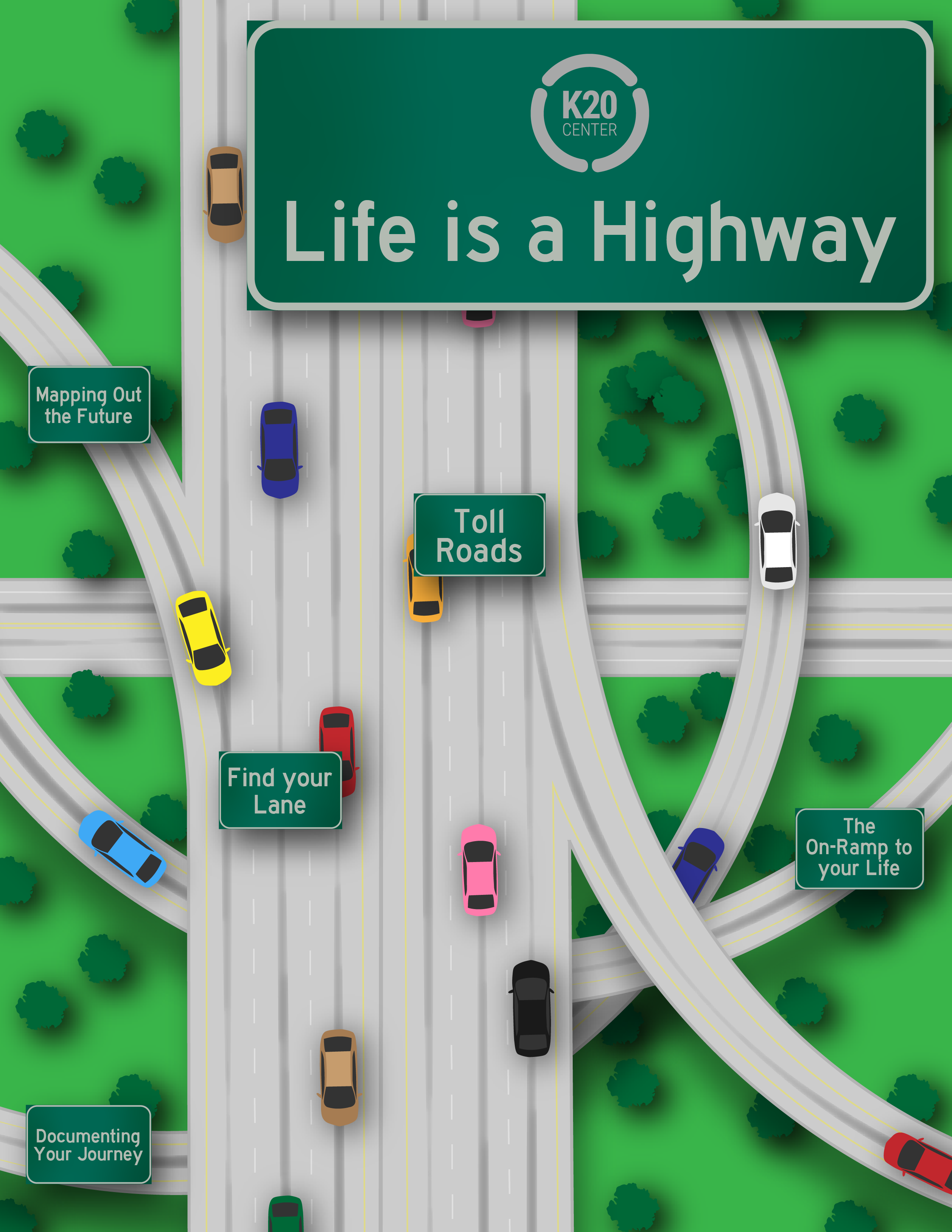Summary
Just like in the board game, "Game of Life," in real life, getting to where you want to be may require you make a few pit stops along the way. Making important life decisions like what career you want, what colleges, technical schools, or certification programs are necessary to help you achieve those career goals. Figuring out how you are going to get there and how you will pay for it are equally important considerations to examine as you continue your journey.
Materials List
Student Activity Packet (attached)
High School Resume Tracker (attached)
Scholarship Tracker (attached)
3-Column Chart (attached)
My Vision Board (attached; optional)
Tablet or personal device
Internet access
Three-Ringed Binder, file box, or similar organizer
Section Dividers with the following headings
Volunteer
Awards
Leadership
Extracurricular
Academics Beyond the Classroom
Sheet protectors (optional to keep awards and documents safe)
Poster board (optional)
Pens/Pencils/Markers/Glue (optional)
Old magazines (optional)
What to Do
Entering the On-Ramp of Your Life. Begin by getting yourself organized by researching basic information for the career you are interested in having.
Finding Your Lane. Once you have begun the journey, determine which exit is right for you. Does the job you want require a college degree? Technical training? Certification programs? An apprenticeship?
Documenting Your Journey. Begin documenting your activities early in high school so that writing essays, letters, and resumes will be easy by the time you are a senior.
Toll Roads: Paying Your Way. Apply for scholarships early on to help pay for your education and training.
Mapping Out Your Future. Create a vision board or a plan that outlines and displays your goals.
Activity #1: Entering the On-Ramp of Your Life
Just like in the popular board game, “The Game of Life,” you have to make occasional stops along the journey that is life. You will be making important decisions that will affect your entire life. Choose the career you want before you become a senior in high school. You will want to make sure you select the right colleges, technical schools, or certification programs that will help you achieve your career goals. All of these are important considerations to keep in mind as you continue your journey. Keep in mind that plans often change due to circumstances that you may not expect.
You may already have a strong idea of what you want to do when you graduate from high school. You may have a clear understanding of what you want your future career to be, and you may already know where you want to go for education and training. But knowing in a general way does not usually provide you with sufficient information for you to make your best choices.
This activity will help you find specific information about your career choice and what you need to do to achieve that goal:
Knowing what skills, training, and education will help you determine where you need to increase your skill set.
Knowing education and skills requirements for your preferred job/career will help you narrow your focus and enable you to choose the right colleges or training academies.
Knowing ahead of time what the average salary is for your preferred job/career will help you determine how much you are willing to spend on an educational/training program.
Knowing your potential salary will influence your decisions about potential student loans.
Instructions:
Visit the website My Next Move. This website will help you gather the necessary information about the careers you are interested in.
There are three ways you can research for information about your desired career:
Search Careers with Key Words. Type in words that relate to what you want to do.
Browse Careers by Industry. Use the drop-down menu to scroll down to careers you are interested in.
Tell Us What You Like to Do. Create your own personal “career profile” by answering questions in the O-Net Interest Profiler. Be candid about your likes and dislikes and your strengths and weaknesses.
As you are planning your profile, consider the following questions:
What is the career title?
What career cluster does this fall under?
What does someone in this job do?
What skills do I need in order to do this job?
What kind of education or training do I need to do this job?
What is the average salary for this career field?
Don’t close the website. You will need it for the next activity.
Activity #2: Finding Your Lane
At this point in your journey, you have an idea of what you would like to do for a living. One of the first questions you should ask is “How do I get there?”
Instructions:
Imagine that you want to become an elementary school teacher. Use teacher as a key word. from the “Search results for teacher,” select Elementary School Teachers from the menu. The screen below is your starting point.
Review the general information about required/recommended Knowledge/Skills/Abilities/Education. Check out the information regarding recommended job requirements, technical skills, and potential salary.
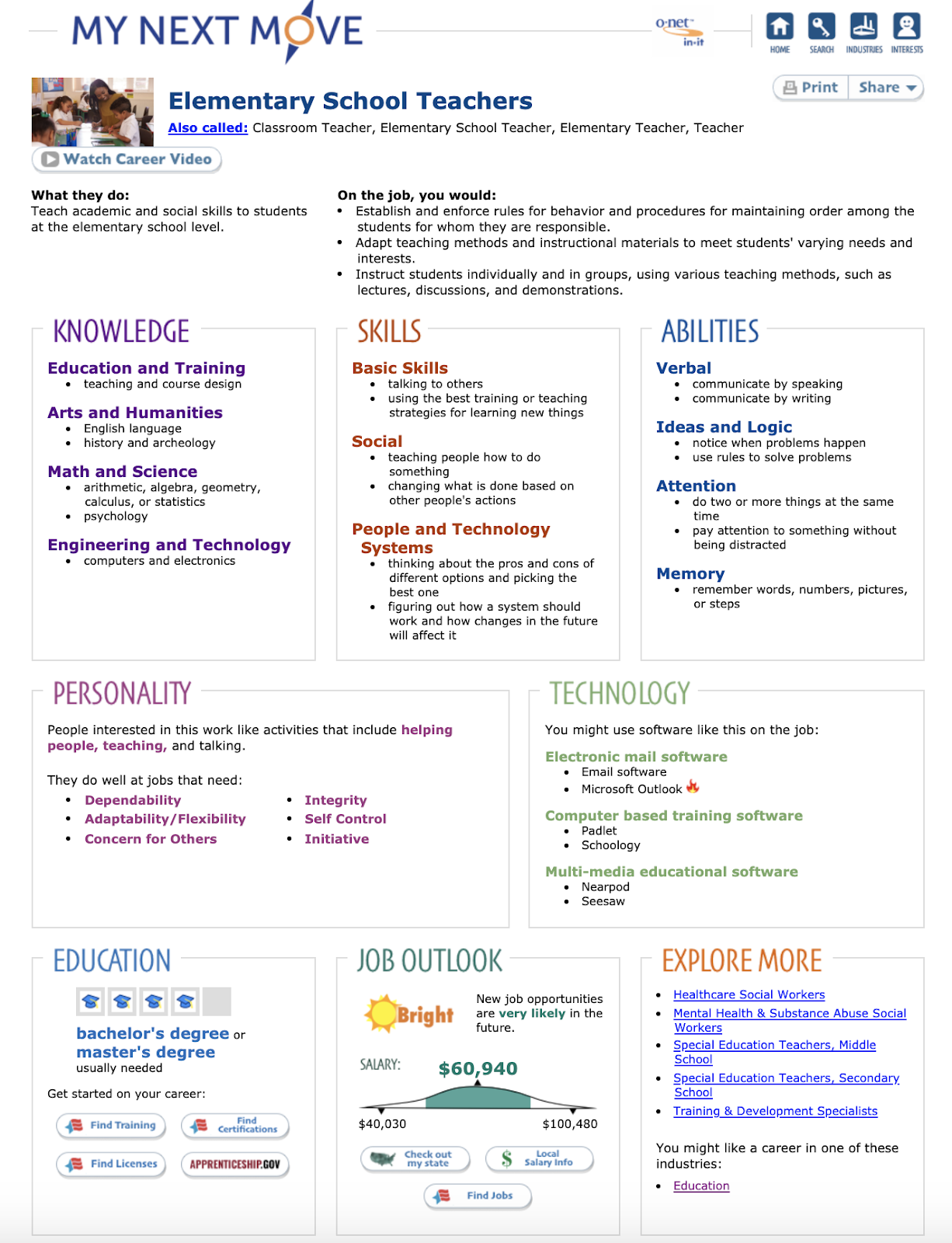
Locate the Education block in the bottom left corner of the page. There are links for you to select:
Find Training
Find Certifications
Find Licenses
Apprenticeship.gov
Select Find Training.
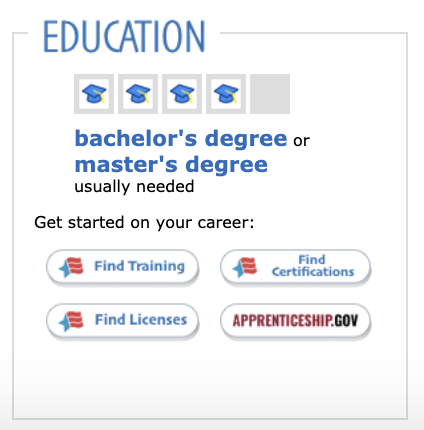
You will be prompted to select the state you want to search. Select Oklahoma. Type in your zip code.
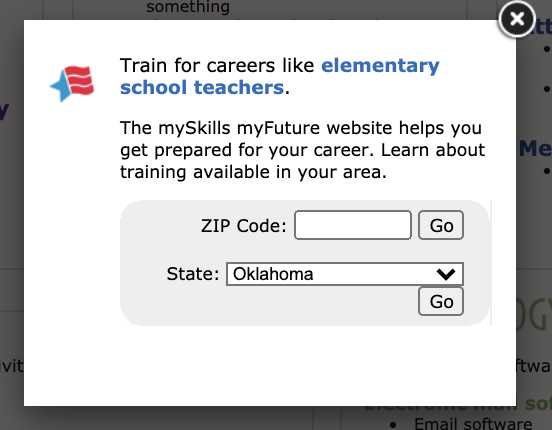
A list of programs will come up for you to search based on your location.
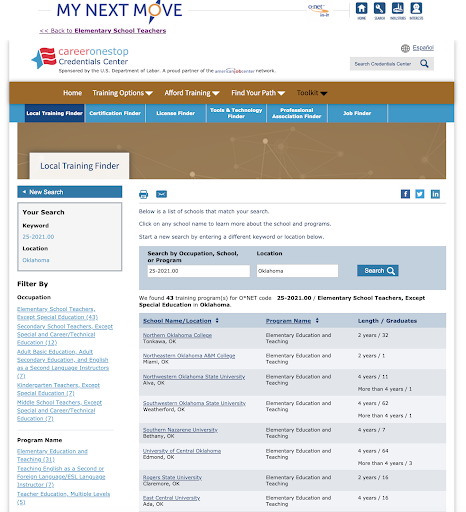
Take time to review at least five of the schools you are interested in.
For each of the programs you visit, create a Pro/Con/Requirements 3-Column Chart. The Chart can be found in the attached Activity Packet. You can choose to print the chart on the next page five times or create your own on a separate sheet of paper or create an electronic copy.
Pros - What draws you to that program? What are the benefits of choosing that school?
Cons - What turns you off about the school? What are the reasons you don’t want to attend that program?
Requirements - Entrance requirements, GPA, SAT/ACT required scores, required prerequisites
As you explore other programs, add information to the Chart.
Activity #3: Documenting Your Journey
Fast forward. It’s your senior year in high school. It’s time to start writing college application essays, letters, and resumes, and highlighting your accomplishments. Remembering everything you have done for the last three or four years ago is challenging. Now is a good time to sit down and set up a system to keep track of your activities and accomplishments so that you do not have to rely solely on your memories.
Do you have what you need to get into the school or program of your choice? If you are directly entering into the job force, how do you make sure you’re sharing all of the wonderful things that you’ve done and can do based on your life experiences.
Instructions:
Before you get started, organize the supplies that will house your materials:
Set up a three-ring binder, a file box, or similar organizer with dividers.
Label your dividers with the following (you may include others as well):
Volunteer
Awards
Leadership (i.e., secretary of class; attended leadership retreat)
Extracurricular (if you were in several organizations, you may want to have a separate section for each)
Academics (beyond the classroom; include study groups, lessons to build skills in art and music, practices and performance, any competitions in events such as bridge building, robotics performances, spelling or math bees).
Your organizer is now ready to hold your records. If you chose a three-ring binder as your organizer, use sheet protectors to save certificates and other documents that you don’t want to hole punch. Take photos of trophies and plaques to place in your organizer.
Use the High School Resume Tracker to capture and organize your experiences.
There are useful logs and forms for you to print and use in your organizer.
Keep your materials up-to-date throughout your high school journey.
You will find, too, that as you go through college, technical training, or on-the-job training, you will benefit if you keep this document current.
Never assume that your current job is your permanent or last job. Most individuals find that they change jobs several times throughout their lives. The work and community activity log will help with job applications.
Activity #4: Toll Roads: Paying Your Way
Based on your review of the schools and programs, you may have concluded that attending colleges and training institutions can be expensive. But just because it costs a lot doesn’t mean there aren’t great resources and scholarship opportunities out there for you! There are two things to keep in mind about scholarships, awards, and grants: (1) In order to receive an award, a grant, or a scholarship, you have to apply for them. It is rare that a scholarship provider will seek you out. Apply for any scholarships that you qualify for. (2) Keep in mind that you do not have to wait until you are a senior to apply for scholarships. You can begin the process of finding and applying for scholarships, awards, and grants as early as 9th grade. Set up and keep track of all the scholarship awards you receive and the important information the providers require.
Instructions:
Take some time to get familiar with the Scholarship Tracker.
Set up a file folder on your computer or personal device to keep digital copies of information that you may need to upload for applications, such as:
Essays you write
Letters of recommendations from teachers, coaches, employees, etc.
Drafts of letters to grant and scholarship providers
Most up-to-date transcripts
Begin by visiting one of the following websites and reviewing some of the scholarships available for you to apply for now!
As you apply for a scholarship, fill in the information on your Scholarship Tracker.
Remember that being awarded a scholarship speaks well of you, so information regarding scholarships and monetary awards should be added to your resume. Even if you receive a small scholarship, you will have been evaluated by a scholarship committee of some organization or club and you will have competed with others for the award. Include that information.
If you have not been selected for a scholarship, grant, or award that you have applied for, do not be discouraged. Remember that there are thousands of students across the country competing for financial aid in one form or another. Not being awarded one scholarship or grant does not indicate that you will not receive others. Be diligent.
Keep your materials up-to-date throughout your high school journey. You will find, too, that as you go through college, technical training, or on-the-job training, you will benefit by keeping this document current. Never assume that your current job is your permanent or last job. Most individuals find that they change jobs several times throughout their lives. The work and community activity log will help with job applications.
Activity #5: Extend: Mapping Out Your Future
Now that you know where you want to go and how you want to get there, it is important to create a vision board so that you can see it every day. Creating a vision board will give you an opportunity to envision your professional and personal goals and aspirations. A visual representation of your plans creates an emotional connection that will motivate you. It enables you to see what steps you need to take in order to make your DREAMS a REALITY. It helps keep you focused on your goals and enables your support system to see and assist you in achieving your goals and aspirations.
Materials:
Poster board
Markers/pens
Old magazines
Glue
My Vision Board (optional)
Instructions for the Poster Vision Board:
Create category names that you can use to help brainstorm what you want to include on your vision board. Some examples that may help you are:
Career - What career is your focus?
Education
What type of education do you need for this career?
What are some clubs or activities that you can focus on to help you accomplish your goals?
What schools do you want to apply to? Include them in your vision board.
Who are your support systems? Who will help you get where you want to be?
What are some things that you can do along the way to take care of your mind, body, and soul? How can you ensure the best and happiest version of you meets these goals?
Look through old magazines or on the internet for images that can represent your goals and each of the keywords that came up during your brainstorming session.
Cut out the images and paste them onto your poster board. They can be organized in a specific way, or they can be glued on randomly. The choice is yours.
Once you have completed your vision board, share it with those in your support system and hang it up where you will see it often.
Instructions for the Digital Vision Board:
Using the attachment, My Vision Board, to design your vision board as a Powerpoint slidedeck. Create category names. Make a separate slide for each category. The categories that could be on your vision board today are as follows:
Career
Education
Self-Care
Support systems,
Create and/or personalize your own category names.
Surf the web for visual representations of your goals. Use online images, illustrations, words, or even songs to communicate your particular goals for that slide.
Once you have decided on pictures, place them on the appropriate slides and create a layout pleasing to you.
Once you have your vision board decorated and completed, share your boards with your support systems.
Sources
CollegeBoard.org. (2021, June 3). College starts here. https://www.collegeboard.org/
CollegeStats.org. (2016, Feb 8). Find the best college degree programs. https://collegestats.org/
Fastweb. (n.d.). Fastweb is your connection to scholarships, colleges, financial aid and more. https://www.fastweb.com/
Finaid.org. (n.d.). The go-to guide for college financial aid. https://finaid.org/
My Next Move. (n.d.). What do you want to do for a living? https://www.mynextmove.org/
Scholarships.com. (n.d.). Get matched to scholarships today. https://www.scholarships.com/
Unigo. (2021, June 2). College scholarships. https://www.unigo.com/scholarships


